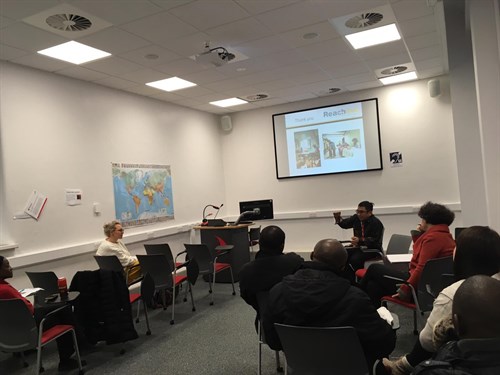DISCUSSING CULTRURAL BARRIERS TO HEALTH FACILITY DELIVERY IN INDONESIA AND ETHIOPIA
Sudirman Nasir

Cultural barriers to health facility delivery are a common experience worldwide despite wide variations in context. Close-to-community (CTC) health providers play an important role in bridging communities and health systems and their role in maternal health is particularly key.
Sudirman Nasir, senior research associate of REACHOUT Indonesia as well as a senior lecturer in the Faculty of Public Health, Hasanuddin University (Indonesia) delivered a public lecture on the above topic in Liverpool School of Tropical Medicine on 13 December 2018. Dr. Nasir came to Liverpool as a visiting fellow supported by a fellowship funded by the Indonesian Ministry of Higher education to write and submit a paper in an academic journal. Dr. Nasir along with several REACHOUT colleagues i.e. Aschenaki Zerihun Kea (Reachout Consortium, Ethiopia), Rosalind Steege (Liverpool School of Tropical Medicine, UK),Ralalicia Limato (Eijkman Institute of Molecular Biology, Indonesia), Patricia Tumbelaka (Eijkman Institute of Molecular Biology, Indonesia), Daniel Gemechu Datiko (Reachout Consortium, Ethiopia), Syafruddin (Eijkman Institute of Molecular Biology, Indonesia), Maryse Kok (Royal Tropical Institute, The Netherlands) Rukhsana Ahmed (Eijkman Insititute of Molecular Biology, Indonesia and Liverpool School of Tropical Medicine, UK) and Miriam Taegtmeyer (Liverpool School of Tropical Medicine, UK) completed and submitted a paper on the above topic in a journal.
During the lecture, Dr. Nasir presented the paper's findings and recommendations. The paper explored the views of CTC maternal health providers and other community members on the cultural barriers to health facility delivery in two districts in Indonesia and six districts of Sidama Zone, southern Ethiopia. Employing a qualitative approach, we conducted 110 semi-structured interviews (SSIs) and 7 focus group discussions (FGDs) in Indonesia and 44 SSIs and 14 FGDs in Ethiopia. Participants in both contexts included mothers, husbands, male community members, traditional birth attendants (TBAs), village heads, local administrators and district health officials as well as health care workers and CTC health providers. Despite significant geographical and cultural differences, the main findings were similar in the two countries’ study areas. These included: strong cultural-religious beliefs; culture of shyness and privacy around pregnancy; highly gendered decision making related to pregnancy and delivery; as well as preference of the TBA care. TBAs’ close proximity at the time of childbirth and their adherence to traditional practices were important factors influencing preference for TBAs. These cultural barriers interplay with geographical, transportation and financial factors hindering pregnant women from delivering at a health facility. Intensifying health promotion on health facility delivery, increasing collaboration among CTC health workers such as community midwives, health extension workers and TBAs, and enhancing responsiveness to traditional practices may overcome cultural barriersto facility delivery in both countries.
The lecture's audience responded with several interesting comments. One of the audience who participated in a study in maternal health related issues in Uganda mentioned several similar findings, particularly preference for TBA care.

This project is funded by the European Union.
